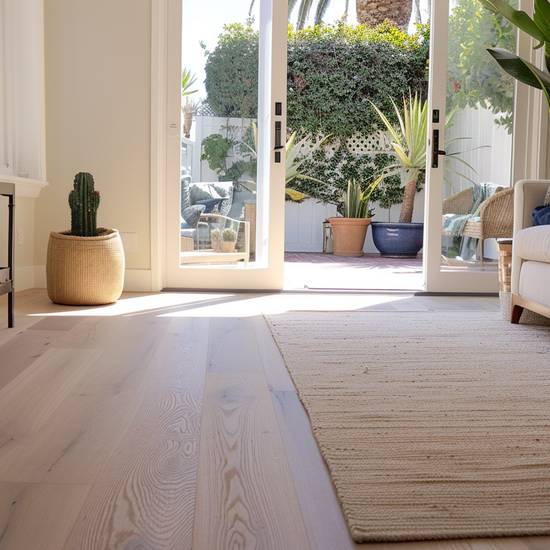Drywall and flooring contractors can make a room feel finished, quiet, and built to last. Hiring one team for both trades keeps schedules tight, seams clean, and finishes cohesive, so you get fewer headaches and better results.
Inside, you will see how a pro runs the construction project, what to ask before you sign, and simple checks that protect your budget and customer service experience.
The Essential Role of Drywall and Flooring
Quality drywall sets the stage for every room. Straight seams, crisp corners, and smooth surfaces come from proper taping, sanding, and priming. Pros choose high-quality drywall materials, the right joint compound, control moisture, and allow full dry times so cracks, ridges, and nail pops do not appear later.
Flooring succeeds when the base is right. Installers flatten and level subfloors, use proper underlayment and moisture barriers, and plan safe transitions at doorways. Then they match materials to real life (hardwood, laminate, or vinyl) so your floors look great, clean easily, and stand up to daily traffic.
Why Choose One Team for Drywall and Flooring?
One qualified general contractor can manage both trades from prep to punch list. That simplifies decisions, speeds the schedule, and reduces mistakes.
Streamlined Communication
You work with one point of contact who sets the calendar, coordinates crews, and answers questions quickly. Fewer handoffs mean fewer surprises.
Better Design Harmony
The same team aligns baseboards, tile heights, and door clearances. Corners, reveals, and transitions match so walls and floors look built together.
Strong Quality Control
One crew owns the results. If an issue shows up, they adjust drywall, underlayment, or trim without finger-pointing, and keep the job moving.
Time and Cost Benefits
Shared protection, demolition, and cleanup reduce overlap. Ordering materials once and staging rooms in sequence helps prevent delays and extra fees.
Works for Homes and Businesses
A versatile team understands small residential repairs and larger commercial spaces like offices and retail. They plan access, dust control, and quiet hours to fit your building.
What to Expect: The Project Journey
Step 1: Conversation and Measuring
Start with a quick chat about goals, budget, and timing. Your contractor checks framing, looks for moisture risks, and measures rooms to confirm square footage and subfloor flatness.
Step 2: Material Choices
Pick materials that fit each space. Use moisture-resistant drywall in baths and laundry rooms, but use cement board/foam backer with a waterproofing membrane in shower or tub surrounds. Use Type X gypsum board where a fire rating is required. Choose flooring based on traffic, pets, and cleaning habits so it looks good and lasts.
Step 3: Written Plan
You receive a clear, line-item scope. It lists drywall removal or patching, floor prep, underlayment or backer board, trim details, and final cleanup, so everyone knows what happens and when.
Step 4: Protection and Demo
Crews protect furniture and pathways, seal off work zones, and control dust. They remove damaged drywall or old flooring safely and haul debris away promptly per the project plan. In homes built before 1978, they follow EPA Lead-Safe Renovation (RRP) practices for paint disturbance.
Step 5: Drywall Installation and Finish
Panels go up, seams are taped, and surfaces are sanded smooth. Proper dry times are scheduled before priming and paint so seams stay clean and corners stay crisp.
Step 6: Floor Preparation and Installation
Subfloors are flattened, squeaks are fixed, and underlayment or backer board is set where needed. Wood, laminate, vinyl, or tile is installed to manufacturer specs for a durable, even finish.
Step 7: Walkthrough and Handoff
Take a final tour with your contractor, note any touch-ups, and get simple care tips and warranty documents. You’ll know how to clean, what to avoid, and who to call if questions come up.
How to Choose the Right Drywall and Flooring Contractor
A good hire starts with clear proof of skill, safety, and planning. Use this quick checklist to compare options side by side.
- Verify Credentials: Ask for licensing, liability insurance, and workers’ compensation. Groups like the Association of the Wall and Ceiling Industry show a focus on standards.
- Check Experience: Look for photos and local references for drywall repair, drywall installation, and flooring services. Ask about commercial spaces and tenant improvements if needed.
- Review Reputation: Read recent customer reviews and Better Business Bureau (BBB) ratings. Make sure the service area covers your city or county.
- Compare Written Quotes: Ask for itemized pricing, a project timeline, and who will be on site. Clear quotes help you save money without surprises.
FAQs About Drywall and Flooring Contractors
How long does a typical project take?
Small rooms may finish in one to two weeks, depending on drying time and flooring lead times. Larger projects take longer.
Which drywall should I use in bathrooms?
Moisture-resistant drywall, such as green or purple board, is best in humid areas. Use Type X gypsum board where codes require fire protection.
Do contractors handle small repairs?
Yes. Many teams fix drywall holes, match textures, and repair flooring so it blends with the rest of the room.
What flooring is easiest to care for?
Vinyl and laminate are low maintenance. Hardwood offers a classic look but needs periodic care. Your contractor will match materials to your routine.
Upgrade Walls and Floors With One Trusted Team
Ready to refresh your space without juggling multiple crews? Share your goals, timeline, and budget. We will match you with vetted drywall and flooring contractors who handle measuring, material selection, professional installation, and a clean handoff.
Mr. Remodel will help you compare clear, itemized quotes and realistic schedules. Choose the partner who communicates well, protects your home, and delivers results that last. Tell us about your project and we will line up competitive bids you can trust.































